Potential and problems in equal measure
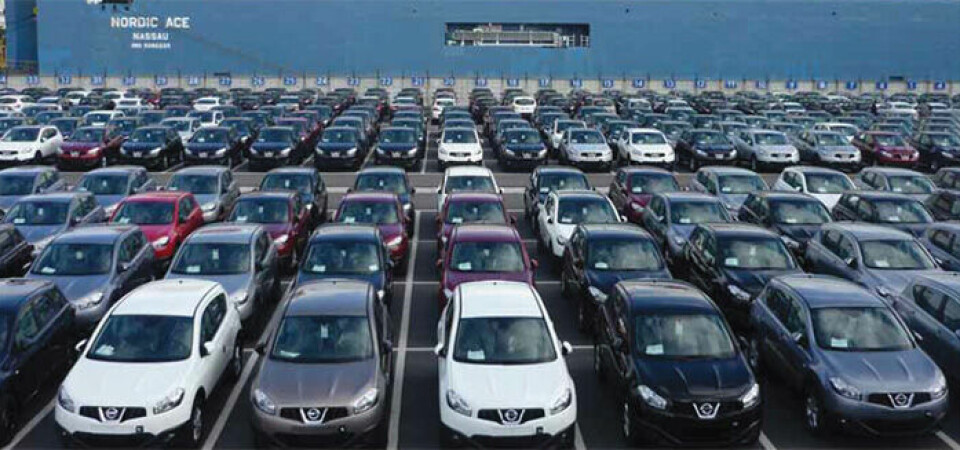
Despite political uncertainty and its recent propensity for economic boom and bust, Russia is still a major growth market for automotive. With LSPs investing heavily in ports, inland terminals and transport assets, Chris Lewis looks at the challenges posed by such a difficult market
Russia has been the star sales performer among European automotive markets, but it remains a difficult one for logistics providers to operate in. A roller-coaster demand profile–from boom to bust and back again in less than half a decade–regulatory challenges and an unpredictable business environment have discouraged some investment since the downturn. But there are signs that both domestic and international vehicle logistics providers are expanding in Russia again following the sales growth. In some ways, the challenges facing logistics providers in Russia today echo those prior to the crash that halved the market in 2009: a shortage of capacity for road, rail and ports; difficult and costly customs procedures; unreliable service and delivery.
But there are also differences in Russia today compared to 2008. For starters, a much higher proportion of the cars sold in Russia are now assembled in the country, which has implications for providers looking to gain market share in the Russian vehicle logistics sector. Increasingly, European companies developing in the Russian market have moved from acting as forwarders to investing in trucks and assets in the country. Russia’s unpredictable rate levels have also encouraged some providers to control their own fleets. The proportion of domestic production is set to increase further since the government signed agreements, known as Decree 166, with several global carmakers, such as Volkswagen, General Motors, Renault Nissan and Ford, to meet production and localisation targets in exchange for free import duties.

Imported vehicles are nevertheless substantial, reaching about 900,000 units last year–or about a third of the market– along with a high number of commercial vehicles. When the government ratifies the terms of Russia’s World Trade Organisation (WTO) membership this year, it will lower some import tariffs on certain commercial vehicles. Tariffs for passenger cars will remain at 25% (from 30% currently) until 2018 as part of the concessions for carmakers who signed Decree 166. These developments underscore the complexities of Russia’s regulatory environment. Political unrest could cause further disruption and despite the government’s attempts to ‘modernise’ the economy, it still depends greatly on the price of oil. Nevertheless, the potential of the Russian market– expected to surpass Germany as the largest market in Europe by 2015–continues to usher in investment in vehicle logistics.
Different strokes
Looking at standard business practices in Russia, one thing that many operators used to working in Western Europe will notice is that things are just done differently here. For example, according to Dominik Buszta, automotive and transportation consultant at Frost & Sullivan, OEMs frequently use two or three LSPs to handle a service that would most likely be handled by a single provider in other countries. Capacity shortages encourage OEMs in Russia to hedge their bets. “OEMs want maximum flexibility–their whole strategy is geared towards that,” says Buszta. A lack of clarity in pricing may also encourage the multiple LSP approach, states Buszta: “All companies have quite random pricing. It seems to depend on their economic situation at that time.”

Russia is a road-dominated market, he says, with trucks accounting for 85-90% of the total distribution and the rest made up of rail and shipping. Rail capacity, too, is limited and can fluctuate from month to month, with the beginning of the year always a difficult time. The length of time a car buyer can expect to wait after ordering a new model in a showroom is not necessarily long, according to Buszta. For a car manufactured in a major city like Moscow or St Petersburg, next-day delivery is possible and even in the remoter cities it may be no more than a week or two. However, if a customer orders a car in an uncommon colour or other specification, delivery times can stretch to two or even three months.
Heavy investment
Uwe Seliger, director of the Central Eastern Europe and Russia business unit at BLG Automobile Logistics, says that Russia is an important market and one in which his company is investing heavily. “There has been a steady increase in requirements in this market, and while we don’t think [sales] will go the same way as 2010/11, everyone is positive.” BLG is involved in two sectors of the market: imported cars via the Baltic, the Black Sea, Vladivostock in the Far East and overland; and in-country logistics from the growing number of Russian-based production plants.
BLG’s approach to Russia has changed since the crisis, Seliger continues. “We realise that we have to directly invest in this market–in ports, inland terminals and transport assets–and in the whole of Russia, not just Moscow and St Petersburg.”
BLG’s investment plan is for €150-200m ($200m-263m) spread over several years. But it decided not to invest in the market alone, signing a joint-venture agreement at the end of 2011 with Fesco, one of Russia’s oldest-established shipping companies that has now diversified into inland logistics. In the past, BLG subcontracted a substantial amount of activity in Russia. Seliger explains: “The first priority will be having our own truck fleet. We are aiming for a minimum of 300 transporters at a cost of around €45m-50m. While Russian truckers can give good service, if you subcontract in this market it is very hard to keep control of your costs as what costs €100 today may cost €200 tomorrow.” Seliger adds that BLG may decide to invest in rail wagons at a later stage, too. Rail is competitive over longer distances of around 2,000km or more, compared to 300-400km in Western Europe.
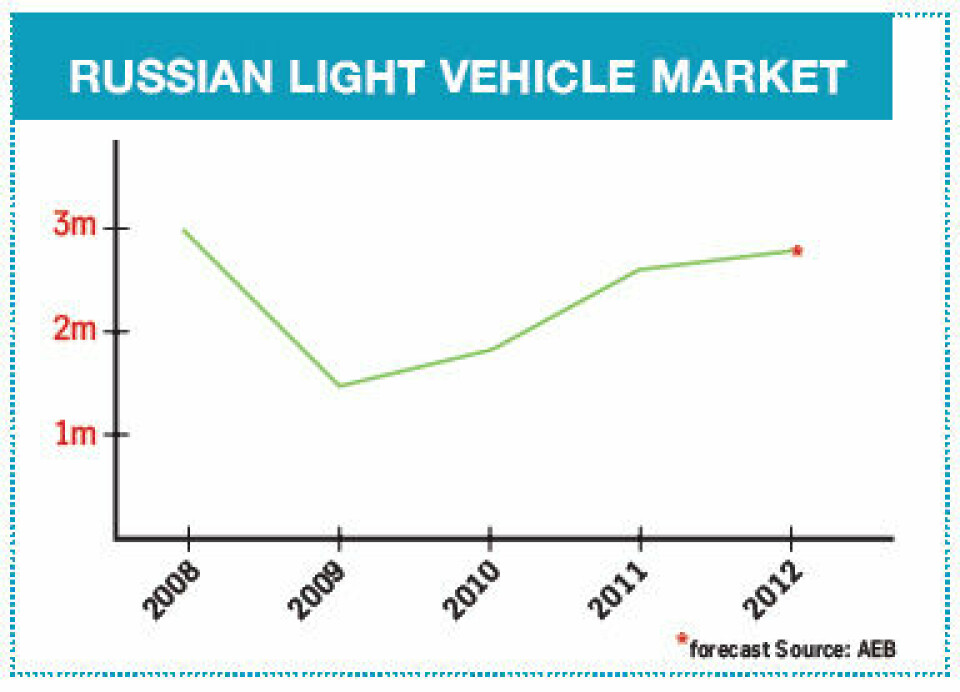
BLG already operates around 1,000 wagons in Western Europe but the company would need a separate fleet for Russia as the Russian railways use a slightly wider track gauge–cars imported from Europe would need to be transhipped between rail wagons at Russia’s borders. However, there is a lack of rail wagon building capacity in Russia at the moment, so this would be a long-term plan.
In time, BLG hopes to counterbalance flows of vehicles to the east of Russia with a return flow from Asia and introduce block trains. However, there are many issues to address before rail can play its full part, including increasing track capacity and removing bottlenecks on the rail system.
As for ports, St Petersburg will remain BLG’s main maritime point of entry for the west of Russia, despite the availability of an alternative at Ust-Luga. Both ports have their positive attributes, according to Seliger, but operations in St Petersburg are much improved, with three car terminal operators vying for business and considerable space having been released. “There was no way you would have handled cars in St Petersburg 5-10 years [ago] but it is completely different now,” says Seliger.
The most difficult area is the Black Sea, where there is currently no suitable Russian port. “There is a lot we could do via the Black Sea. Traffic could be routed via our hub in Gioia Tauro, in Italy, and Turkey is also emerging as a major automotive manufacturer. [Turkish manufacturers] need to export and Russia would be an obvious destination.” There are some major ports on the Black Sea but these are all in Ukraine and border formalities are such that rebuilding a Russian port looks to be a more immediate solution than easing customs flows. Seliger says that Russian Black Sea ports currently under evaluation are Taganrog, Tuapse, Kavkaz and Novorossiysk.
Coping with growth
Konstantin Skovoroda, chairman of the board at Russian specialist logistics provider RTL, says that the market remains as unpredictable as ever, though currently it seems to be performing better than the expected forecast of 8-10% growth. “We are happy we are growing, but we have to be ready for any scenario,” he continues.
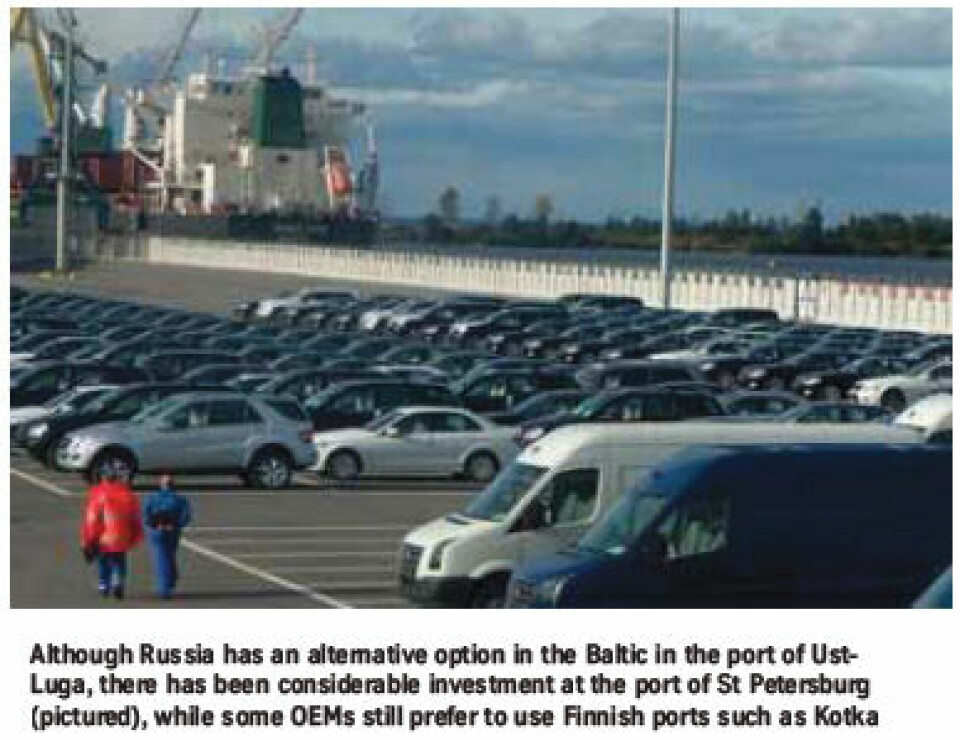
Russia is facing a difficult period politically, with the recent re-election of Vladamir Putin as president. While a change in
the Kremlin’s political complexion is unlikely to lead to any great alterations to government policy regarding the car industry or international trade, the continued uncertainty is not good for the industry, Skovoroda believes. Meanwhile though, manufacturers such as Nissan and Toyota are increasing their production and RTL will continue to develop its logistics services both for imports and domestically-produced vehicles.
“For our biggest client, the Renault Nissan Alliance, whether it’s imports or Russian plants’ production, we are putting all cars into one system–and we would like to do something similar for our other clients,” Skovoroda says. Skovoroda describes RTL’s asset investment as “huge”. It is developing a new car terminal at Ust-Luga and another in the south of Russia. It is also making heavy investment in its truck fleet with the purchase of around 200 new transporters. Like BLG, RTL has been reducing its reliance on subcontractors because, as Skovoroda says, “you can make more money and operate in a more efficient way if you use your own [assets]”. However, he acknowledges that a totally owned fleet is risky in a volatile market like Russia as “during a crisis you might end up with half your fleet idle.” He believes that Ust Luga will develop into a major player in the Russian port industry, though RTL will continue to use the port of St Petersburg too. Skovoroda believes that eventually, St Petersburg will be used mainly for local distribution, as it faces significant congestion problems–it can take three hours to get a truck in and out, not to mention the traffic in the St Petersburg urban area.
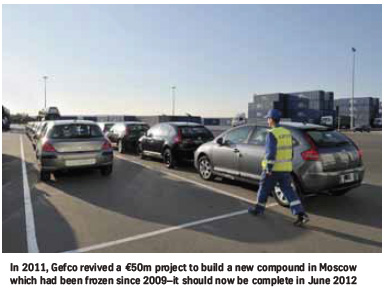
Finding partners for growth
Gefco’s Christian Zbylut, CEO of the company’s Eastern Europe, Russia and Central Asia division, is maintaining his faith in a market which, despite a dip in 2008, has generally been a promising one. Recovery is now well in hand, he says, although growth in 2012 probably won’t be as vigorous as in 2011. “Most western manufacturers will increase their production inside Russia–the only question is when,” he believes.
In 2011, Gefco revived a €50m project to build a new compound in Moscow which had been frozen since 2009–it should now be complete in June 2012. “I think that shows our commitment to this market and that investment in Russia is still worth doing,” says Zbylut.
Gefco is also spreading further afield within Russia, including at Nizhny Novgorod, a traditional manufacturing base that is seeing new investment. GAZ Group will begin producing cars on a contract basis for the VW Group, GM and Daimler, for example (see Automotive Logistics, April-June 2012, p22). “Production is modest at the moment, but it will ramp up in 2012/13,” Zbylut says. Other areas of Russia, such as Yekaterinburg, will be targeted in due course.
Gefco has invested in its vehicle fleet to the tune of 150 transporters last year and has a large renewal plan for the next 12 months. The company operates two Russian fleets, one 100% Gefco-owned and the other as part of its Algai joint venture, which accounts for a further 200 transporters. It also uses around 600 subcontracted vehicles.
Subcontractors are necessary in this market but it takes time to find good ones, says Zbylut. The haulage sector was hardhit by the last economic downturn, when an estimated 1,500 transporters were taken out of service. Many were stored, but the harsh Russian climate has taken its toll and many are no longer fit for service. “These are now starting to be missed,” Zbylut explains. However, smaller hauliers are struggling to obtain finance to reinvest in their fleets.
Gefco, which owns a substantial rail wagon fleet in Europe, typically only uses the mode in Russia for distances of around 3,000km and above. The Moscow compound is rail-connected and the service from the Russian railways is generally good, Zbylut finds. Ultimately, Gefco would like to turn the rail area at its Moscow site into a customs area, mainly to handle imports.
Access and infrastructure
At Wallenius Wilhelmsen Logistics, Russia branch managing director Søren Tousgaard Jensen and Axel Bantel, VP and head of commercial for Europe, both agree that Russia is both “an exciting and very challenging market” where carmakers are open to new solutions and suggestions. “Russia is very much an open door at the moment and there are many good opportunities,” explains Jensen. “The main problem though, is that growth is outpacing infrastructure and long-term planning is very challenging based on ongoing economic volatility.”
The Baltic will remain the main gateway for deep-sea trade into Russia, Bantel believes, but volume will be split between Finland, St Petersburg and Ust-Luga, and other smaller ports. While, as an ocean-going shipping operator, WWL likes to serve as few ports as possible in a region, this will probably not be possible in the foreseeable future in Russia. “The infrastructure isn’t there, there are challenges with customs clearance and there are the preferences of the importer,” says Bantel.
There are some other important access points to this vast country, in particular the far eastern ports such as Vladivostok and Nakhodka. For these ports, the Transiberian railway is a lifeline and will also be the main access route for growing Russian markets east of the Urals, Bantel predicts. However, there is currently a capacity squeeze on this route as well as issues over reliability and pricing consistency. Russian exports and containerised traffic have priority– including empty wagons being returned for reloading–so capacity for car trains and large machinery is limited at the moment. “We have a number of customers in the Baltic region who are considering using ships to Vladivostok rather than the rail route and some Russian truck manufacturers prefer to drive their products under their own power to customers in the Russian Far East,” says Jensen.
A flexible future
Looking into the future, Bantel adds that the key to this large and sometimes unpredictable market is being able to offer customers a door-to-door system of different routings and service options. An arrangement that works well at one time of the year may not be viable at other times, and rapid shifts in the market can wrong-foot those who are too reliant on one particular mode of transport or corridor. While the proportion of locally-produced cars is increasing, imports are still expected to rise in absolute terms from 900,000 a year in 2011 to 1.1m in 2015, says Jensen. Moreover, the proportion of the market for trucks and wheeled machinery accounted for by imports is likely to remain high. WWL, which has a strong focus on ‘high-and-heavy’ cargo as well as break-bulk project cargo, expects strong growth in the next decade from these sectors and from infrastructure development projects.
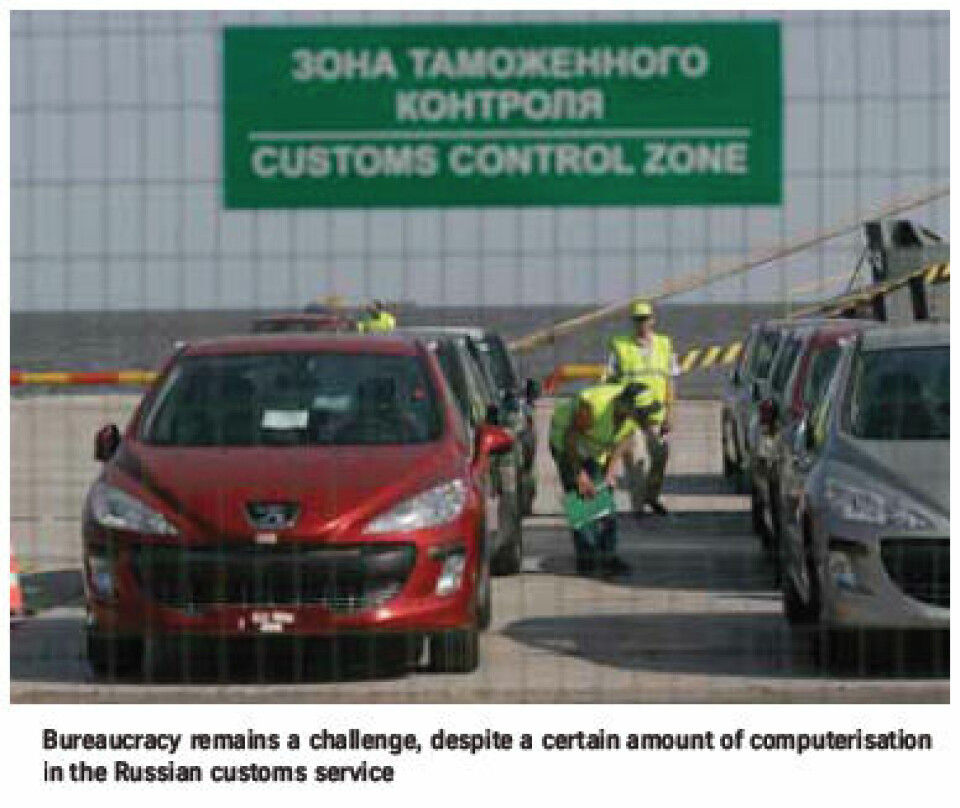
Bureaucracy remains a challenge, despite a certain amount of computerisation in the customs service. For vehicle importers, there is the added issue that cars are subject to excise as well as customs duty, so there are two sets of processes to go through. As well as customs, commercial paperwork is on the heavy side–certain procedures need to be in place, such as official signed agreements, before one company can invoice another. WWL is now working on closing up the gaps in its Russian network. Ports and shipping are generally well covered but it would like to do more in inland transport. While primarily an investor in ships, terminals and vehicle processing facilities, WWL does invest in inland transport in some markets–often as a way of entering markets and understanding local dynamics prior to selecting local partners–and this approach may work well in Russia.
Russia is a market whose potential may be only matched by its difficulties. The infrastructure deficits are unlikely to be resolved quickly, even as investment in ports and equipment continues. In many ways, Russia is a market that is likely to retain certain imbalances for automotive, such as a lack of export flows, although Zbylut sees some potential for exports to grow at least to neighbouring countries Belarus and Kazahkstan, which joined Russian in forming a customs union last year.
But change will not come overnight and a long-term view will be necessary for Russia. Seliger sums it up well: “Russia can be a hard market to gauge. Our philosophy is that we have to take some risk, but not make any stupid decisions. But it’s a major market and it is growing, though it is hard to manage because the volumes go up and down.
“But it’s market of 150m people in front of our door–and we can’t afford to ignore that.”





